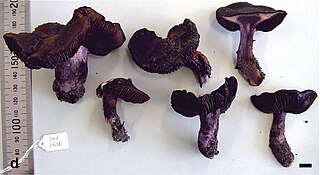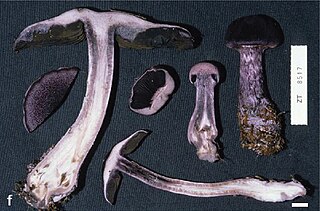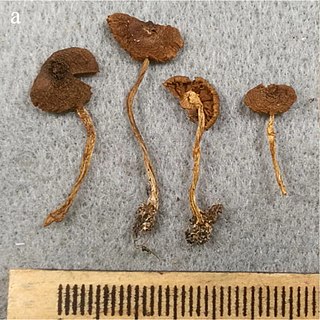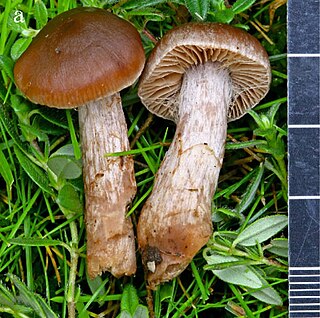
Cortinarius rubellus, commonly known as the deadly webcap, is a species of fungus in the family Cortinariaceae, native to high-latitude temperate to subalpine forests of Eurasia and North America. Within the genus it belongs to a group known as the Orellani, all of which are highly toxic. Eating them results in kidney failure, which is often irreversible. The mushroom is generally tan to brown all over, with a conical to convex cap 2.5 to 8 centimetres in diameter, adnate gills and a 5.5 to 11 cm tall stipe.

Cortinarius is a globally distributed genus of mushrooms in the family Cortinariaceae. It is suspected to be the largest genus of agarics, containing over 2,000 widespread species. A common feature among all species in the genus Cortinarius is that young specimens have a cortina (veil) between the cap and the stem, hence the name, meaning curtained. Most of the fibres of the cortina are ephemeral and will leave no trace once gone, except for limited remnants on the stem or cap edge in some species. All have a rusty brown spore print. The common names cortinar and webcap refer to members of the genus. Due to dangerous toxicity of several species and the fact that it is difficult to distinguish between various species of the genus, non-expert consumption of mushrooms from the genus is discouraged.

The Cortinariaceae are a large family of gilled mushrooms found worldwide, containing over 2100 species. The family takes its name from its largest genus, the varied species of the genus Cortinarius. Many genera formerly in the Cortinariaceae have been placed in various other families, including Hymenogastraceae, Inocybaceae and Bolbitiaceae.

Cortinarius rotundisporus, also known as the elegant blue webcap, is a basidiomycete mushroom of the genus Cortinarius found in southern Australia, where it is found in eucalypt forests and rainforests. The cap of the fruit body is a steely blue colour, with a yellowish boss, and paler similarly coloured stipe.

Cortinarius violaceus, commonly known as the violet webcap or violet cort, is a fungus in the webcap genus Cortinarius native across the Northern Hemisphere. The fruit bodies are dark purple mushrooms with caps up to 15 cm (6 in) across, sporting gills underneath. The stalk measures 6 to 12 centimetres by 1 to 2 cm, sometimes with a thicker base. The dark flesh has a smell reminiscent of cedar wood. Forming symbiotic (ectomycorrhizal) relationships with the roots of various plant species, C. violaceus is found predominantly in conifer forests in North America and deciduous forests in Europe.

Cortinarius archeri is a species of mushroom in the genus Cortinarius native to Australia. The distinctive mushrooms have bright purple caps that glisten with slime, and appear in autumn in eucalypt forests.

Meinhard Michael Moser was an Austrian mycologist. His work principally concerned the taxonomy, chemistry, and toxicity of the gilled mushrooms (Agaricales), especially those of the genus Cortinarius, and the ecology of ectomycorrhizal relationships. His contributions to the Kleine Kryptogamenflora von Mitteleuropa series of mycological guidebooks were well regarded and widely used. In particular, his 1953 Blätter- und Bauchpilze [The Gilled and Gasteroid Fungi ], which became known as simply "Moser", saw several editions in both the original German and in translation. Other important works included a 1960 monograph on the genus Phlegmacium and a 1975 study of members of Cortinarius, Dermocybe, and Stephanopus in South America, co-authored with the mycologist Egon Horak.

Cortinarius porphyroideus, commonly known as purple pouch fungus, is a secotioid species of fungus endemic to New Zealand. It was one of six species that appeared as part of a series depicting native New Zealand fungi on stamps, released in 2002.

Cortinarius kioloensis is a fungus native to Australia. It was described in 2009 by Alec Wood, and is related to the Northern Hemisphere species Cortinarius violaceus.

Cortinarius hallowellensis is a fungus native to Western Australia and Tasmania. It was described in 2009 by Alec Wood, and is related to the northern hemisphere species Cortinarius violaceus. The main species in the North America group, Cortinarius monticola, has also been identified, but has not been found in Australia. Despite this relative isolation, there is genetic interchange between the North American species and the Australian species.

Cortinarius carneipallidus is a fungus native to New Zealand. It was described in 2015 by Emma Harrower and Egon Horak, and is related to the northern hemisphere species Cortinarius violaceus.

Cortinarius palatinus is a fungus native to Costa Rica. It was described in 2015 by Emma Harrower and colleagues, and is closely related to the northern hemisphere species Cortinarius violaceus.

Cortinarius neotropicus is a fungus native to Costa Rica. It was described in 2015 by Emma Harrower and colleagues, and is closely related to the northern hemisphere species Cortinarius violaceus.

Cortinarius altissimus is a fungus native to Guyana. It was described in 2015 by Emma Harrower and colleagues, and is closely related to the northern hemisphere species Cortinarius violaceus.
Cortinarius subcalyptrosporus is a fungus native to Borneo, where it was originally collected by E.J.H. Corner on the slopes of Mount Kinabalu in 1964 and described by Meinhard Michael Moser in 1986. Specimens from New Zealand classified as this species are Cortinarius kioloensis. It is poorly known.
Cortinarius atroviolaceus is a fungus native to Borneo, where it was originally collected by E.J.H. Corner on the slopes of Mount Kinabalu in 1964 and described by Meinhard Michael Moser in 1986. Specimens from New Zealand classified as this species are probably a different species. It is poorly known.

Cortinarius subsaniosus is a species of webcap mushroom known from north and central Europe, where it grows on sandy soil in association with willows. It produces small yellowish brown mushrooms. The species was described in 2020 by Kare Liimatainen and Tuula Niskanen. Its name refers to its affinity to C. saniosus, to which it is closely related. Along with five other British webcaps, C. subsaniosus was selected by Kew Gardens as a highlight of taxa described by the organisation's staff and affiliates in 2020.

Cortinarius ainsworthii is a species of webcap. It is known from central and Northern Europe, where it grows in a variety of habitats. The species was first described in 2020, and was named in honour of the mycologist A. Martyn Ainsworth. Along with five other British webcaps, C. ainsworthii was selected by Kew Gardens as a highlight of taxa described by the organisation's staff and affiliates in 2020.

Cortinarius heatherae is a species of webcap. It was described in 2020 by Andy Overall from a specimen found at Heathrow Airport. He named the species in honour of his wife, Heather Overall. Along with five other British webcaps, C. heatherae was selected by Kew Gardens as a highlight of taxa described by the organisation's staff and affiliates in 2020.















